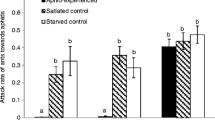Abstract
Females of the aphid parasitoidParalipsis enervis received liquid food by regurgitation (trophallaxis) from workers of the ant speciesLasius niger, but were not fed by workers ofMyrmica laevinodis andTetramorium caespitum. WhileP. enervis was not treated aggressively by workers of any of these species,Lasius flavus workers killed the parasitoid. This different ant behaviour resulted in a different parasitoid longevity. WhileP. enervis survived for only 10 min in the presence ofL. flavus (due to ant aggression) or for approximately one day in the presence ofT. caespitum andM. laevinodis (due to lack of trophallaxis), survival increased significantly to more than five days in the presence ofL. niger, which provided food regularly to the parasitoids. Our study suggests thatP. enervis mimics behavioural signals ofL. niger, as well as odor cues of its host aphidAnoecia corni, to avoid aggression byL. niger.
Similar content being viewed by others
References
Hölldobler, B., Sci. Am.224 (1971) 86.
Hölldobler, B., and Wilson, E. O., The Ants. Springer, Berlin 1990.
Kistner, D. H., in: Social Insects. Vol. 1, p. 339. Ed. H. R. Herrmann. Academic Press, New York 1979.
Howard, R. W., McDaniel, C. A., and Blomquist, G. J., Science210 (1980) 431.
Vander Meer, R. K., and Wojcik, D. P., Science218 (1982) 806.
Vander Meer, R. K., Jouvenaz, D. P., and Wojcik, D. P., J. chem. Ecol.15 (1989) 2247.
Dettner, K., and Liepert, C., A. Rev. Entomol.39 (1994) 129.
Hölldobler, K., Mitt. schweiz. ent. Ges.20 (1947) 607.
Buckley, R., A. Rev. ecol. Syst.18 (1987) 111.
Nixon, G. E. J., Comm. Inst. Entomol., London (1951) 1
Pierce, N. E., in: Oxford Surveys in Evolutionary Biology. Vol. 4, p. 89. Ed. P. Harvey and L. Partridge. Oxford University Press, Oxford 1987.
Sudd, J. H. in: Aphids. Their Biology, Natural Enemies and Control. Vol. 2A, p. 355. Eds A. K. Minks and P. Harrewijn. Elsevier, Amsterdam 1987.
Way, M. J., A. Rev. Entomol.8 (1963) 307.
Addicott, J. H., Can. J. Zool.57 (1979) 558.
Pierce, N. E., and Easteal, S., J. Anim. Ecol.55 (1986) 451.
Way, M. J., Bull. Ent. Res.45 (1954) 113.
Eisner, T., Hicks, K., Eisner, M., and Robson, D. S., Science199 (1978) 790.
Mason, R. T., Fales, H. M., Eisner, M., and Eisner, T., Naturwissenschaften78 (1991) 28.
Liepert, C., and Dettner, K., J. chem. Ecol.19 (1993) 2143.
Mackauer, M., and Völkl, W., Oecologia94 (1993) 339.
Völkl, W., J. Ins. Behav.8 (1995) 653.
Völkl, W., and Mackauer, M., J. Ins. Behav.6 (1993) 301.
Völkl, W., J. Anim. Ecol.61 (1992) 273.
Mackauer, M., and Stary, P., World Aphidiidae. Le Francois, Paris 1967.
P. enervis is a synovigenic solitary endoparasitic species (see ref. 29). Females emerge from the aphid mummies with some mature eggs, and additional eggs develop throughout adult life. Like most all aphid parasitoid species belonging to the family Aphidiidae, adult food is mainly required for selfmaintenance rather than for the maturation of additional eggs. Females lay their eggs into the body of a living aphid. The oviposition process lasts between 25 and 50 s.
Maneval, H., Bull. Soc. Linn. Lyon9 (1940) 9.
Pontin, A. J., Entomologist's mon. Mag., London95 (1960) 154.
Stary, P., Ins. Soc.13 (1966) 185.
Stary, P., Biology of Aphid Parasites, with Respect to Integrated Control. Ser Ent 6. Dr. W. Junk, Den Haag 1970.
Zwölfer, H., Z. ang. Ent.43 (1958) 1.
Takada, H., and Hashimoto, Y., Kontyu53 (1985) 150.
Kaib, M., Heinze, J., and Ortius, D., Naturwissenschaften80 (1993) 281.
Nowbahari, E., Lénóir, A., Clément, J. L., Lange, C., Bagnères, A. G., and Joulie, C., Biochem. Syst. Ecol.18 (1990) 63.
Obin, M. S., J. chem. Ecol.12 (1986) 1965.
Bonavita-Cougourdan, A., Clément, J. L., and Lange, C., J. entomol. Sci.22 (1987) 1.
Bonavita-Cougourdan, A., Clément, J. L., and Poveda, A., Actes Coll. Ins. Soc.6 (1990) 273.
Lénoir, A., Clément, J. L., Nowbahari, M., and Lange, C., Actes Coll. Ins. Soc.4 (1988) 71.
Morel, L., Vander Meer, R. K., and Lavine, B. K., Behav. Ecol. Sociobiol.22 (1988) 175.
Vander Meer, R. K., Saliwanchik, D., and Lavine, B., J. chem. Ecol.15 (1989) 2115.
Howard, R. W., Akre, R. D., and Garnett, W. B., Ann. ent. Soc. Am.83 (1990) 607.
Stanley-Samuelson, D. W., Howard, R. W., and Akre, R. D., Ann. ent. Soc. Am.83 (1990) 1108.
Blomquist, G. J., and Dillwith, J. W., in: Comprehensive Insect Physiology, Biochemistry and Pharmacology. Vol. 3, p. 117. Eds G. A. Kerkut and L. I. Gilbert. Pergamon Press, New York 1985.
Howard, R. W., in: Insect Lipids: Chemistry, Biochemistry and Biology, p. 197. Eds D. W. Stanley-Samuelson and D. R. Nelson. University of Nebraska Press, Lincoln 1993.
Henderson, G., and Akre, R. D., J. Kansas Ent. Soc.59 (1986) 454.
Hölldobler, B., Naturwissenschaften55 (1968) 397.
Hölldobler, B., Z. vergl. Physiol.66 (1970) 215.
Eastop, V. F., Proc. R. ent. Soc. Lond. A41 (1966) 42.
Petal, J., Ekol. Pol.28 (1980) 297.
Author information
Authors and Affiliations
Rights and permissions
About this article
Cite this article
Völkl, W., Liepert, C., Birnbach, R. et al. Chemical and tactile communication between the root aphid parasitoidParalipsis enervis and trophobiotic ants: consequences for parasitoid survival. Experientia 52, 731–738 (1996). https://doi.org/10.1007/BF01925584
Received:
Revised:
Accepted:
Issue Date:
DOI: https://doi.org/10.1007/BF01925584




